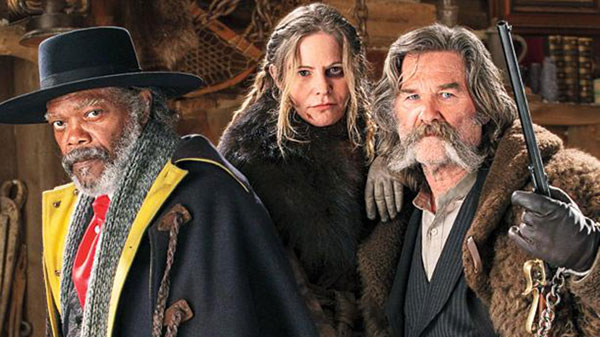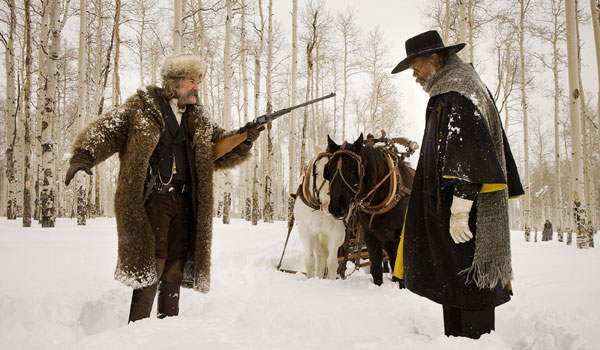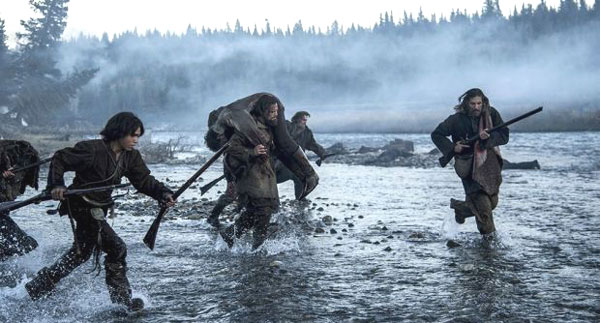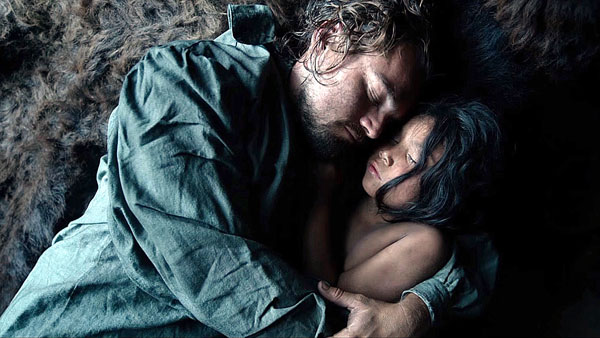|
Two recent films, Quentin Tarantino’s The Hateful Eight and Alejandro G. Inarritu’s The Revenant, take place in
wintry Wild West landscapes of endless beauty and foreboding, with frequent outbursts of frenetic violence. One film is more persuasive than the other, but both can
rightfully be described as punishing. They are both films I’m glad I saw—once.
The Hateful Eight is the jokier of the two films, with Tarantino’s screenplay hewing closely to his usual, circular story
structure. The opening shot is of a grotesque, snow-covered wood sculpture that turns out to be Christ on the cross. A stagecoach plows through the snow, bearing bounty
hunter “Hangman John” Ruth (Kurt Russell) and his prisoner Daisy Domergue (Jennifer Jason Leigh). Presently, the stagecoach is forcibly stopped by a man
dragging three corpses. This turns out to be Maj. Marquis Warren (Samuel L. Jackson), an old acquaintance—though not necessarily a friend—of
Ruth’s. Warren demands a ride so he can go to collect a bounty on the corpses; Ruth reluctantly lets him in.

After a while, they encounter another man on foot, Chris Mannix (Walton Goggins), who claims to be the new sheriff of the town
Ruth and Warren are traveling to. Mannix also requests a ride. Neither Ruth nor Warren is happy to see Mannix, the son of a
notorious Confederate renegade. They don’t believe Mannix is really the new sheriff, but they give him a ride anyway.
The ensuing stagecoach ride serves two purposes: to present necessary exposition seamlessly through the conversation
between the three men (Daisy remains malevolently silent), and to establish that these characters all hate each other, with good reason.
The general air of malevolence increases exponentially when the travelers arrive at a way station inexplicably named “Minnie’s
Haberdashery.” Instead of Minnie and her usual crowd, the foursome arrives to meet yet another old enemy, ex-Confederate
Gen. Sandy Smithers (Bruce Dern), and three strangers: executioner Oswaldo Mobray (Tim Roth); stable hand Bob (Demian Bichir); and Joe Gage (Michael Madsen), a mysterious
cowboy who claims to be writing his memoirs.
From this point, it is absolutely no fair to reveal the Pandora’s
Box of surprises Tarantino has in store for the audience. As with most of his previous films, Tarantino tells his story through
extended conversations that explode into mayhem, along with flashbacks and the occasional bit of narration. Not all of the
characters are who they say they are, and one turns out to be better than the others at figuring out what’s going on.
Meanwhile, a very famous actor (named in the opening credits, but I will not mention his name here) plays a crucial role in both the main flashback and the ending.
The Hateful Eight is a masterfully constructed film that creates a pervasive air of impending doom, its characters trapped in a
cabin surrounded by endless, inescapable winter. In creating this, Tarantino receives major help from cinematographer
Robert Richardson, production designer Yohei Taneda, and especially composer Ennio Morricone, whose sweeping, ferocious score is as brilliant as anything in his six-decade
career. The actors—most of them Tarantino regulars—are absolutely first-rate, with Jackson, Russell and Leigh vying with
each other to see who can steal the most scenes.

If craft alone could make a masterpiece, The Hateful Eight would be one. Unfortunately, the film feels hollow at its core.
Some critics have gone so far as to call The Hateful Eight Tarantino’s worst film. I disagree—The Hateful Eight is considerably better than Death Proof or the two parts of Kill
Bill—but in the end Tarantino does a poor job of justifying the film’s existence.
It helps to compare The Hateful Eight with the Tarantino films that immediately preceded it—Inglourious Basterds and Django
Unchained. Both films had the same circular structure, the same extended stretches of dialogue, the same pitch-dark sense
of humor, and the same frequent bursts of transgressive and sometimes nauseating violence. However, Inglourious Basterds and Django Unchained are transgressive in other, more salutary
ways. Both are revenge fantasies that seek catharsis against historic atrocities—World War II in the case of Inglourious Basterds, and American slavery in the case of Django
Unchained. In giving happy if ultra-violent endings to these films, Tarantino makes an effective argument for cinema as a transformative art.
The Hateful Eight, however, is nothing more than a good Wild West yarn, and therefore when the violence comes it feels
gratuitous. The story simply can’t bear the weight of all the gore. It takes us out of the story, flattens it, and trivializes it. This is
too bad, because everything else about The Hateful Eight is excellent. But it is one of Tarantino’s rare miscalculations.
The Revenant is the better film of the two, though I’m not
certain it’s quite as great a film as some people say it is. It does, however, create an insinuating portrait of the old Western
wilderness, at once mythic and bloody, magnificent and forbidding.
Based partly on a novel by Michael Punke and partly on actual historical events, the screenplay by Inarritu and Mark L. Smith
is set in the 1820s Northwest, beginning with a fur-trapping expedition led by Capt. Andrew Henry (Domhnall Gleeson).
Hugh Glass (Leonardo DiCaprio), a seasoned frontiersman haunted by visions of his dead Pawnee wife, is the expedition’s
guide, accompanied by his teenage son Hawk (Forrest Goodluck).
Inarritu throws us immediately into the violence. Only a couple of minutes in, the expedition is attacked by a band of Arikaras.
The casualties are heavy, and what remains of the expedition escapes in a flatboat.

The Arikaras, however, are not finished. The chief is searching for his kidnapped daughter, and suspects the trappers of being
the culprits. Captain Henry, realizing his men will be too easy to find if they stay on the river, orders an overland escape. Glass is
scouting a trail through the woods when he is suddenly attacked by a grizzly. Finding Glass horribly mauled, Henry orders John
Fitzgerald (Tom Hardy) and the very young Jim Bridger (Will Poulter) to stay with Glass and Hawk until Glass is well enough to travel.
However, Fitzgerald—a solipsistic coward and thug--thinks the assignment is a death sentence, with the Arikara likely to strike
at any time. What Fitzgerald chooses to do, and the consequences of his actions, forms the bulk of the plot of The Revenant. Some reviewers have told you more about the story; I
will not. I will merely say it is a revenge story of epic proportions, with scenes of violence as explicit as anything in a Tarantino
movie, but presented far more earnestly and with a greater sense of tragedy. If you have seen the trailer, you know that the
bear attack is merely the first of many horrors Hugh Glass must endure.
Inarritu has established himself as the cinema’s poet of sorrow, as his curriculum vitae establishes: Amores Perros, 21 Grams,
Babel, Biutiful. (Birdman has more humor than the others, but still concerns a main character consumed with disappointment and regret.) The Revenant may be the most mournful of all
these films, displaying death and the struggle for survival at the most basic level. The bear attack alone, taking several minutes
of screen time, is one of the most horrific cinematic depictions of man vs. nature, and stands as a metaphor for the entire film.
Hugh Glass and the other characters are trapped in a pitiless wilderness in which lethal danger is never more than a second
away, and in which mistakes are always punished in full.

Emmanuel Lubezki, Inarritu’s regular cinematographer, filmed the wintry Canadian landscapes of The Revenant in natural light,
creating a breathtaking, perpetually twilit landscape. It’s as if Whistler and Albert Bierstadt collaborated on a series of wilderness paintings.
Yet, for all the beauty on display, Inarritu never lets us forget the
constant peril of being in the midst of that beauty. The scene in which Glass hollows out the carcass of a dead horse, so he can
crawl inside and escape freezing to death, illustrates that perfectly.
Generally speaking, The Revenant portrays its Pawnee and Arikara characters sympathetically. Native American
commentators, however, have still found the film patronizing. “That’s kinda the way Hollywood historically uses Native people
and black bodies, as lesson providers and tragic figures,” said Gyasi Ross, a writer and attorney from the Blackfeet Nation, in his Huffington Post article on The Revenant. “We usually don’t
live long enough to see the glory of the white man’s redemption, but instead have to be killed so that the white protagonist can
find his or her humanity.” I would have to reveal too much of the story to demonstrate why Ross is right about The Revenant, but he is.
Ross’ critique of The Revenant helps explain why the film just
misses greatness. A director such as Terrence Malick has built a career on making movies about limited characters dwarfed by
their surroundings. Inarritu attempts something similar here, but as always he is focused intensely on his characters. That is the problem with The Revenant. Hugh Glass, as Ross points
out, is “dirty, vicious, capitalistic and brutal.” He is more sympathetic than his antagonist Fitzgerald largely by dint of his
vastly greater suffering. This is not at all to detract from the work of DiCaprio, who once again proves himself one of the
greatest living actors. Few actors have ever attempted a role as physically grueling as that of Hugh Glass, and DiCaprio certainly
finds the humanity in the character, especially in the film’s enigmatic, ineffably sad final scene. But even he can’t make
Glass seem like a great man, and all the other white characters are so much smaller, especially Fitzgerald.
Tom Hardy (who previously co-starred with DiCaprio in a much different film, Inception) is memorable as Fitzgerald, a type
found far too often throughout history. Looking Out for Number One is his only idea of morality, and he will accomplish that goal
by any means necessary. Because Fitzgerald is so hateful, and because Glass undergoes such a prolonged ordeal, we root for
Glass. But the story of Glass’ revenge against Fitzgerald is the whole movie, and it’s not quite enough.
|